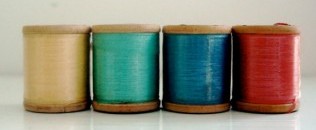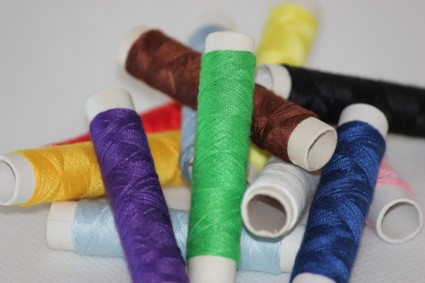Take me back to the sewing thread’s history!! 
Sewing thread has been around for centuries!! It started out as being made from animal hides being cut into thin strips, animal tendons, sinew or twine. Other types of thread were made from plant fibers, such as what the Egyptians used and became very skillful at making. They used not only plant fibers, but the hair of their domestic animals in spinning as well!
There were many different ancient tribes that used local plants or trees to make their threads, the best threads were made from reeds, cactus and honeysuckle.
During this time, spindles were beginning to be used to spin the thread. They were very taxing to use and they would only produce about 20 grams of thread and it had to be spun 500 times to get that! Continuous improvements of the spindle made it easier to use and produced more thread.
The Phoenicians and Egyptians used plants and berries to dye their thread into various colors. They began the pioneering of the dyeing industries by devising these techniques. The Japanese and Chinese discovered how to spin thread from silk fibers, in 350 BC, from silk worm cocoons, as well as making silk fabric.
From about the 1600 BC era to the 1100 BC era, the Assyrians and Babylonians came along and invented the concept of embroidery and that spread out across Persia and Egypt where embroidery was added to the Pharaohs robes!
 Cotton was a big to do during that time as well, some say that Cleopatra’s clothing was made from the finest cotton growing in the Nile valley. In other parts of the world, like Mexico, pieces of cotton fabric were found, possibly dating around 7000 years old!
Cotton was a big to do during that time as well, some say that Cleopatra’s clothing was made from the finest cotton growing in the Nile valley. In other parts of the world, like Mexico, pieces of cotton fabric were found, possibly dating around 7000 years old!
The first machine spun cotton thread started in England in 1730, from there the British colonies picked it up and the idea spread like fire throughout the world!!
You didn’t start seeing artificial silk until it was invented by Earl Hilaire de Chardonnet, in 1884, using solute cellulose for the first time ever and succeed. It wasn’t industrial grade until 1891; it was later named in 1924 as “Rayon” instead of artificial silk.
Today, you can find all kinds of thread made from various materials, weights, colors, etc. You have cotton, polyester, rayon, cotton/polyester mix, nylon, fusible and wool. You even have metallic and thread that dissolves when washed!
You even have different weights to choose from. You have light, thin, normal, upholstery and heavy weight. It all depends on what you are sewing and how much durability you want. Different countries use different weight systems, example the US uses a system that was adopted from the Japanese, the Gunze Count.
